
The Hindi Belt, also known as the Hindi Heartland, is a linguistic region encompassing parts of northern, central and eastern India where various Northern, Western, Eastern and Central Indo-Aryan languages subsumed under the term 'Hindi' are spoken. The Hindi belt is sometimes also used to refer to nine Indian states whose official language is Modern Standard Hindi, namely Bihar, Chhattisgarh, Haryana, Jharkhand, Madhya Pradesh, Rajasthan, Uttar Pradesh, Himachal Pradesh, Uttarakhand and the union territory of Chandigarh and the National Capital Territory of Delhi. It is also sometimes broadly referred to as the Hindi–Urdu Belt or Hindustani Belt.

Grand Chord is part of the Howrah–Gaya–Delhi line and Howrah–Allahabad–Mumbai line. It acts as a link between Sitarampur, (Asansol), and Pt. Deen Dayal Upadhyay Junction, Uttar Pradesh, previously known as Mughalsarai Junction, and covers a stretch of 450.7 km (280.1 mi). The Coal India Corridor line that branches off from Dhanbad Junction and rejoins the Grand Chord at Son Nagar Junction is another major coal loading hub. It is a fully electrified, triple line section from Pt. Deen Dayal Upadhyay to Son Nagar and double line section from Son Nagar to Sitarampur. There are plans to triple the lines from Son Nagar to Dhanbad to accommodate the increasing traffic.. The entire line lies under the jurisdiction of three divisions, Mughalsarai railway division, Dhanbad railway division and Asansol railway division. The Grand chord section is the lifeline of the country, 2nd busiest railway section of India after Ghaziabad, Uttar Pradesh to Pt. Deen Dayal Upadhyay Junction, Uttar Pradesh Main Line section, on which coal, steel and other important goods are moved from Eastern section to Western and Northern sections of the country. In the down direction, the traffic consists of mostly food grains, fertilizers and empty wagons for coal loading in the Jharkhand and West Bengal coal fields. Pt. Deen Dayal Upadhyay Junction is a transit division and the main objective is to maintain mobility of high density traffic. The present capacity of the Grand Chord is being optimally utilized. Traversing through Chota Nagpur Plateau of Jharkhand as well as parts of the fertile Gangetic plains of Bihar, the Grand Chord covers a stretch of 450.7 km (280.1 mi). The Grand Chord is renowned for its remarkable controlling of passenger traffic, despite being burdened with freight traffic.
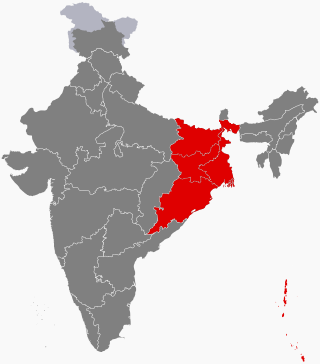
East India is a region of India consisting of the Indian states of Bihar, Jharkhand, Odisha and West Bengal and also the union territory of the Andaman and Nicobar Islands. The region roughly corresponds to the historical region of Magadha from which it inherits its various Eastern Indo-Aryan languages.

Dainik Bhaskar is India's largest Hindi-language daily newspaper owned by the Dainik Bhaskar Group. According to Audit Bureau of Circulations, it is ranked 3rd in the world by circulation and is the largest newspaper in India by circulation. Started in Bhopal in 1958, it expanded in 1983 with the launch of Dainik Bhaskar's Indore edition. Dainik Bhaskar Group is present in 12 states with 65 editions in Hindi, Marathi and Gujarati.
Bairgania is a town and notified area in the Sitamarhi district in the state of Bihar, India. Bairgania is one of the blocks of Sitamarhi districts and is a border of India that links Nepal via Rautahat District through a custom checkpoint. Bairgania is the first town of India that is located on the bank of the Bagmati River.It has a good government medical hospital and experience doctors such as alumni from PMCH.

Old National Highway 2 or Old NH 2, was a major National Highway in India, that connected the states of Delhi, Haryana, Uttar Pradesh, Bihar, Jharkhand and West Bengal. It constitutes a major portion of the historical Grand Trunk Road along with old NH 91 and old NH 1 in India. The highway connects national capital Delhi with Kolkata as well as important cities such as Faridabad, Mathura, Agra, Kanpur, Allahabad, Varanasi, Dhanbad, Asansol, Durgapur and Bardhaman.
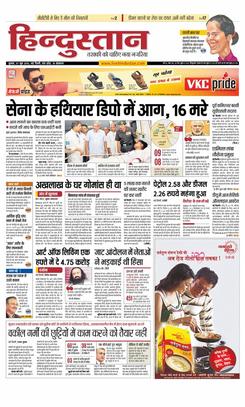
Hindustan Dainik is an Indian Hindi-language daily newspaper. According to Audit Bureau of Circulations, it is ranked 13th in the world by circulation and 6th in India. Madan Mohan Malaviya launched it in 1936. It is published by Hindustan Media Ventures Limited. Earlier it was part of HT Media Ltd group, which spun off its Hindi business into a separate company named Hindustan Media Ventures Limited in December 2009.
Aj is a Hindi language daily broadsheet newspaper in India, currently published from 12 cities in Bihar, Jharkhand, Uttar Pradesh and Uttarakhand states.
Bihar is a state situated in Eastern India. It is surrounded by West Bengal to the east, Uttar Pradesh to the west, Jharkhand to the south and Nepal to the north.
Muslim Rangrezz are a community of Muslim Rajputs in North India. Many members of the community migrated to Pakistan after independence and settled in Karachi, Sindh.
The Muslim Gaddi are a Muslim community found mainly in northern India. After the independence in 1947, the Gaddi of the states of Haryana and Delhi migrated to Pakistan and are now found in the provinces of Punjab and Sindh. In Pakistan and North India, some community members have started to refer to themselves as Ghazi in a way to reconstruct identity.
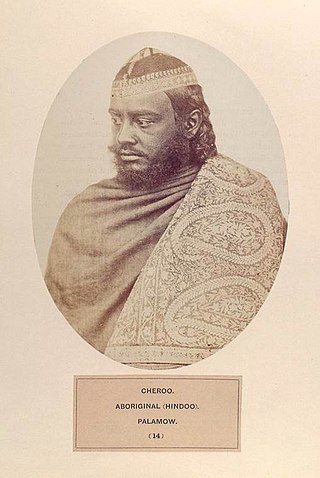
The Chero is a caste found in the states of Bihar, Jharkhand and Uttar Pradesh in India.

The Bihar State Milk Co-Operative Federation Ltd is a state government cooperative under the ownership of Ministry of Cooperation, Government of Bihar. It was established in 1983 as a state government cooperative of the Government of Bihar, India. It markets its products under the label "Sudha Dairy". The co-operative facilitates the procurement, processing, and marketing of dairy products. It provides education to the unions on efficient dairy processing, and assists them with animal care including artificial insemination, vaccination, and feeding.
Most of the languages of Bihar, the third most populous state of India, belong to the Bihari subgroup of the Indo-Aryan family. Chief among them are Bhojpuri, spoken in the west of the state, Maithili in the north, and Magahi in the south. Of these, only Maithili has official recognition under the Eighth Schedule to the Constitution of India. The official language of Bihar is Hindi, with Urdu serving as a second official language in 15 districts.

The Bhuiyan or Bhuiya are an indigenous community found in the Indian states of Bihar, Jharkhand, Madhya Pradesh, Odisha, Uttar Pradesh and West Bengal. They are not only geographically disparate but also have many cultural variations and subgroups.
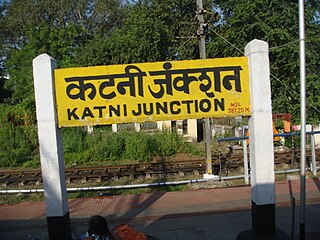
Katni Junction is a major rail junction in Katni, India. Rail links from the junction travel in five directions — Bina, Jabalpur, Satna, Bilaspur, Singrauli. Rail links from the junction travel to New Delhi, Mumbai, Vadodara, Howrah, Chennai, Bangalore, Dhanbad, Allahabad, Kanpur, Lucknow, Bhopal, Indore, Gwalior, Agra, Gorakhpur, Muzaffarpur, Patna, Chandigarh, Ludhiana, Ambala, Bathinda, Jaipur, Jodhpur, Ajmer, Nagpur, Pune, Jammu, Raipur, Bhubaneswar, Visakhapatnam, Hyderabad, Hubli, Madurai, Vasco, Rameshvaram, Kanyakumari, Ernakulam and other Indian cities. To reduce the junction's load the new Katni Murwara & Katni South has been opened to carry trains from Bina and Jabalpur respectively.
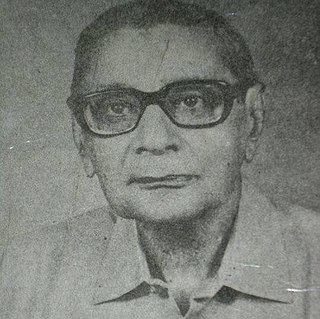
Raza Naqvi Wahi was an Indian Urdu-language poet during his time. He used the takhallus of Wahi.
Sagauli Junction railway station is a junction railway station in East Champaran district, Bihar. Its code is SGL. It is on the Delhi–Muzaffarpur–Gorakhpur main line
Amity University may refer to one of several universities in India:
Varanasi–Kolkata Expressway, also known as Varanasi–Ranchi–Kolkata Expressway, is an approved 610 km (380 mi) long, six-lane, greenfield access-controlled expressway, which will connect the holy city of Varanasi in Uttar Pradesh with the capital of West Bengal, Kolkata, through the capital of Jharkhand, Ranchi. It will run almost parallel with the Grand Trunk Road or the Asian Highway 1, and will pass through four states–Uttar Pradesh, Bihar, Jharkhand and West Bengal. The expressway is a part of Bharatmala Pariyojana, and it will reduce both travel time and distance, from 12-14 hours to only 6-7 hours, and from 690 km (430 mi) to 610 km (380 mi). It will start from Chandauli district in Uttar Pradesh, and will terminate near Uluberia, Howrah district, West Bengal.












